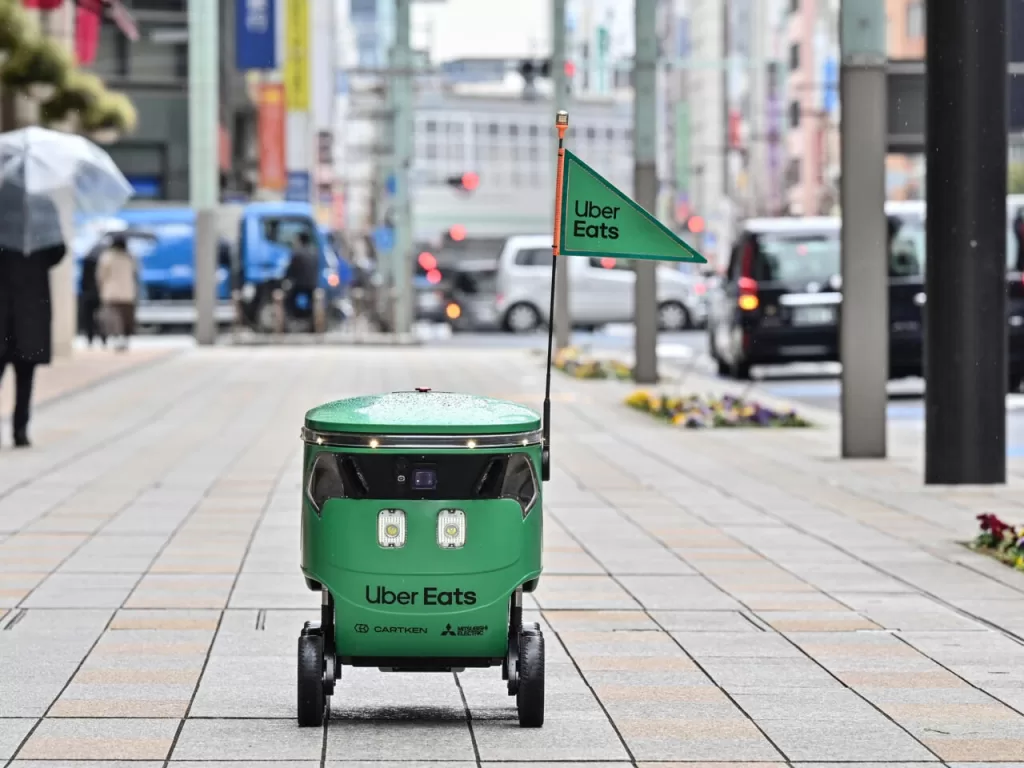Uber Eats Launches Self-Driving Robot Delivery Service in Tokyo
In a major step towards automation in last-mile delivery, Uber Eats has launched a self-driving robot delivery service in parts of Tokyo. The food delivery giant aims to tackle labor shortages and increase efficiency by deploying a fleet of autonomous robots to bring meals directly to customers’ doorsteps.
These cutting-edge robots will navigate the streets of the Japanese capital, ushering in a new era of contactless delivery powered by advanced robotics and artificial intelligence.
The robots, capable of entering elevators and buildings, represent a significant evolution in Uber Eats’ delivery capabilities.
By leveraging self-driving technology, the company hopes to streamline its operations and provide a seamless experience for customers in one of the world’s most densely populated urban centers.
Uber Eats Robot Delivery Details

The star of Uber Eats’ new service is a boxy, wheeled robot that stands about knee-high. With square “headlights” for eyes and six wheels to navigate curbs and obstacles, these self-driving machines use sensors and AI to calculate their routes and avoid pedestrians and other obstacles.
Moving at a maximum speed of 5.4 kilometers per hour, the robots are equipped with flashing lights and a distinctive chirping sound to alert bystanders to their presence.
For now, the robot delivery service is limited to a small area in Tokyo’s bustling Nihonbashi district, with only a few participating restaurants.
Customers within the designated zone will have the option to receive their orders via robot delivery, but they cannot specifically request this service. If a robot is assigned to their order, they will receive a notification and can choose to accept or decline the robotic courier.
The delivery process is designed to be simple and contactless. Once an order is placed, the robot will autonomously navigate to the restaurant, pick up the food, and then make its way to the customer’s location using its built-in navigation system.
While the robots are designed to operate independently, a human operator will be on standby to take control if necessary, ensuring maximum safety during this initial pilot phase.
Uber Eats Delivery Robot Rationale and Benefits
Japan, like many developed nations, is facing a severe labor shortage, particularly in the service and delivery sectors. This shortage has been exacerbated by the COVID-19 pandemic, which led to a surge in demand for food delivery services as more people opted to stay home.
By introducing self-driving robots into its delivery fleet, Uber Eats aims to alleviate the strain on its human workforce and maintain a reliable service level, even during periods of high demand.
Beyond addressing immediate labor needs, Uber Eats sees the robot delivery service as a long-term solution for Japan’s aging population and rural areas. As the country’s demographics continue to shift, with fewer working-age individuals and an increasing number of elderly residents, the availability of delivery drivers in remote areas is expected to decline.
The self-driving robots could bridge this gap, ensuring that even those living in sparsely populated regions have access to convenient food delivery services.
Uber Eats Delivery Robots Rollout and Future Plans
While the initial rollout is limited to a small area of Tokyo, Uber Eats has ambitious plans to gradually expand the robot delivery service across the city and eventually to other parts of Japan.
However, the company acknowledges that this expansion will not happen overnight and that challenges and limitations need to be addressed along the way.
One of the key hurdles is navigating Japan’s intricate regulatory landscape, which has only recently been updated to allow delivery robots on public streets.
Additionally, user acceptance and trust in the technology will play a crucial role in the success of the initiative. Uber Eats plans to closely monitor feedback and performance during the pilot phase, making necessary adjustments and improvements before scaling up the service.
“We are not specifying the number of robots yet, but we will be testing and piloting this small-scale launch first before we expand,” said market operations director at Uber Eats Japan. “Our goal is to integrate these robots seamlessly into our existing team of human delivery partners, not replace them entirely.”
Uber Eats Delivery Robots Reaction and Perspectives
During a demonstration, the robot delivery service garnered a mix of reactions from onlookers. While some expressed amazement at the futuristic technology, others raised concerns about potential collisions and safety risks.
“It’s so cute and eye-catching,” said a 60-year-old bystander. “I thought it might bump into people’s feet, but people seem to give way to it.”
Tokyo locals also acknowledged the potential benefits of the robots in addressing Japan’s labor shortage, stating, “Japan has an aging, dwindling population, with a serious labor shortage. So this is a very good idea for Japan too.”
Industry experts have also weighed in on the development, with some praising Uber Eats’ forward-thinking approach and others questioning the long-term viability of the technology.
“Automated delivery solutions like these robots could be a game-changer for companies like Uber Eats, especially in densely populated urban areas where traffic and parking can be major headaches,” said logistics consultant at Deloitte Japan. “However, the success of such initiatives will hinge on public acceptance, regulatory support, and the ability to scale up operations efficiently.”
Uber Eats Delivery Robots
As the world’s first major metropolitan area to embrace self-driving delivery robots on a commercial scale, Tokyo is poised to become a testing ground for this innovative technology.
Uber Eats’ foray into robotic delivery represents a significant step towards a future where automation and human workers coexist, each playing a crucial role in meeting the ever-growing demand for convenient, contactless delivery services.
While the initial rollout may be modest, the potential implications of this initiative are far-reaching. If successful, it could pave the way for wider adoption of self-driving delivery robots across Japan and beyond, revolutionizing the last-mile delivery landscape and addressing labor shortages in an aging society.